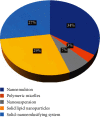A Revolutionary Blueprint for Mitigation of Hypertension via Nanoemulsion
- PMID: 35463984
- PMCID: PMC9023159
- DOI: 10.1155/2022/4109874
A Revolutionary Blueprint for Mitigation of Hypertension via Nanoemulsion
Abstract
Hypertension is one of the most important causes of mortality, affecting the health status of the patient. At the same time, hypertension causes a huge health and economic burden on the whole world. The incidence and prevalence of hypertension are rising even among young people in both urban as well as rural communities. Although various conventional therapeutic moieties are available for the management of hypertension, they have serious flaws such as hepatic metabolism, reduced dose frequency, poor aqueous solubility, reduced bioavailability, and increased adverse effects, making the drug therapy ineffective. Therefore, it is required to design a novel drug delivery system having the capability to solve the constraints associated with conventional treatment of hypertension. Nanotechnology is a new way of using and manipulating the matter at the molecular level, whose functional organization is measured in nanometers. The applications of nanotechnology in the field of medicine provide an alternative and novel direction for the treatment of cardiovascular diseases and show excellent performance in the field of targeted drug therapy. Various nanotechnologies based drug delivery systems, such as solid lipid nanoparticles, nanosuspension, nanoemulsion, liposome, self-emulsifying systems, and polymeric nanoparticles, are available. Among them, nanoemulsion has provided a niche to supplement currently available therapeutic choices due to numerous benefits like stability, ease of preparation, enhanced drug absorption, reduced hepatic metabolism, increased dose frequency, enhanced bioavailability, and encapsulation of hydrophilic as well as hydrophobic drugs. This present review provides an in-depth idea about progression in treatment of hypertension, constraints for antihypertensive drug therapy, need of nanoemulsions to overcome these constraints, comparative analysis of nanoemulsions over other nanostructure drug delivery systems, pharmacodynamics studies of nanoemulsions for treatment of hypertension, recent patents for drug-loaded nanoemulsions meant for hypertension, and marketed formulations of nanoemulsions for hypertension.
Copyright © 2022 Girish Kumar et al.
Conflict of interest statement
The authors declare no conflicts of interest.
Figures







Similar articles
-
Nanoemulsion as Oral Drug Delivery - A Review.Curr Drug Res Rev. 2020;12(1):4-15. doi: 10.2174/2589977511666191024173508. Curr Drug Res Rev. 2020. PMID: 31774040 Review.
-
Nanoemulsion: A Novel Drug Delivery Approach for Enhancement of Bioavailability.Recent Pat Nanotechnol. 2020 Dec 24;14(4):276-293. doi: 10.2174/1872210514666200604145755. Recent Pat Nanotechnol. 2020. PMID: 32496999 Review.
-
Nanoemulsions in drug delivery: formulation to medical application.Nanomedicine (Lond). 2018 Oct;13(19):2507-2525. doi: 10.2217/nnm-2018-0088. Epub 2018 Sep 28. Nanomedicine (Lond). 2018. PMID: 30265218 Review.
-
An Updated Review on Nanoemulsion: Factory for Food and Drug Delivery.Curr Pharm Biotechnol. 2024;25(17):2218-2252. doi: 10.2174/0113892010267771240211124950. Curr Pharm Biotechnol. 2024. PMID: 38415490 Review.
-
A Comprehensive Review on Nanoparticles as Drug Delivery System and Their Role for Management of Hypertension.Curr Pharm Biotechnol. 2025;26(2):169-185. doi: 10.2174/0113892010291414240322112508. Curr Pharm Biotechnol. 2025. PMID: 38566387 Review.
Cited by
-
Enhancing therapy with nano-based delivery systems: exploring the bioactive properties and effects of apigenin.Ther Deliv. 2024;15(9):717-735. doi: 10.1080/20415990.2024.2386928. Epub 2024 Sep 11. Ther Deliv. 2024. PMID: 39259258 Review.
-
Amelioration of Cancer Employing Chitosan, Its Derivatives, and Chitosan-Based Nanoparticles: Recent Updates.Polymers (Basel). 2023 Jul 1;15(13):2928. doi: 10.3390/polym15132928. Polymers (Basel). 2023. PMID: 37447573 Free PMC article. Review.
-
Curcumin Nanoemulsion: Unveiling Cardioprotective Effects via ACE Inhibition and Antioxidant Properties in Hypertensive Rats.Medicina (Kaunas). 2023 Sep 29;59(10):1748. doi: 10.3390/medicina59101748. Medicina (Kaunas). 2023. PMID: 37893466 Free PMC article.
-
Nanocarriers in Tuberculosis Treatment: Challenges and Delivery Strategies.Pharmaceuticals (Basel). 2023 Sep 26;16(10):1360. doi: 10.3390/ph16101360. Pharmaceuticals (Basel). 2023. PMID: 37895831 Free PMC article. Review.
-
Statistical optimization of tetrahydrocurcumin loaded solid lipid nanoparticles using Box Behnken design in the management of streptozotocin-induced diabetes mellitus.Saudi Pharm J. 2023 Sep;31(9):101727. doi: 10.1016/j.jsps.2023.101727. Epub 2023 Aug 2. Saudi Pharm J. 2023. PMID: 37638219 Free PMC article.
References
Publication types
MeSH terms
Substances
LinkOut - more resources
Full Text Sources
Medical

